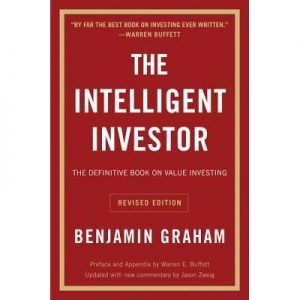 The Intelligent Investor is by far the most well respected investment philosophy book in modern history. The author Benjamin Graham was a world renowned investor and mentor to Warren Buffett, who is well-known in modern times as the world’s most successful investor. Warren Buffett has publicly stated that much of what he bases his investment thought on is from the philosophy of this book. This book will provide you with the basic fundamentals of successful long-term investing and will undoubtedly make you a smarter investor.
The Intelligent Investor is by far the most well respected investment philosophy book in modern history. The author Benjamin Graham was a world renowned investor and mentor to Warren Buffett, who is well-known in modern times as the world’s most successful investor. Warren Buffett has publicly stated that much of what he bases his investment thought on is from the philosophy of this book. This book will provide you with the basic fundamentals of successful long-term investing and will undoubtedly make you a smarter investor.
Investing vs. Speculation
Investing vs. speculation is the basic premise behind this book; Graham advises that if one is to expect consistent success in the investing world, one must be investing rather than speculating. He defines speculating as chasing after “hot” stocks that are already trading well above their true value and are also very popular in the news. This cannot be thought of as investing because one is not evaluating a company based on its future growth prospects, but simply taking a hopeful chance on a stock that is already performing well. The book notes, that ironically, these types of “hot” stocks in U.S. equity markets and globally have traded poorly long-term.
Defensive vs. Enterprising Investor
Graham describes two types of investors. The defensive investor is one that aims to take less relative risk, but does not aim to for returns that are consistently above market (measured by the S&P). On the other hand, the enterprising investor will aim to take adequate risk in return for potential outsized gains. The author sets financial parameters that each type of investor will take in order to obtain their given return profile.
Investing and Market Fluctuations
Essentially – this section of the book warns the common investor that they will see, especially if they are investing in common stock, fluctuations in the value of their investments from time to time. The main guidance, which has been stressed before on this site, is that if one is investing in well-established, large-capitalization, fundamentally sound companies, they should expect to see gains over the long-term. However, despite the attractiveness of these companies, when systematic risk brings the market downward, these stocks will decline in value, maybe significantly, and an investor will have to remain logical, and not sell their investments before they are given the time to once again appreciate in value.
Margin of Safety
The concept of a margin of safety applies to all types of security investing, but is discussed here in greatest detail in relation to common stock investing. This concept can be used as an investor to determine how safe from a repayment standpoint their equity investment is. For example, say that an industrial company has property and equipment worth $20 million, and they have common stock outstanding of $10 million. There is clearly a margin of safety because investors know their initial investment is protected by $20 million in value, and they also have access to any potential upside the company’s earnings. The author goes into a bit greater technical detail, but we will leave this description high-level.
Dollar-cost Averaging
This is a somewhat well-known concept in investing which simply states to invest a fixed amount of money on a set basis (for example, monthly) assuming that in this respect, one will buy less shares when prices are high (potentially overvalued) and will buy more shares when prices are low (potentially undervalued). This will, over the long-term, force an investor to take advantage of value investing – purchasing securities at below their value on an average basis.
Note that this book may be one that is quite confusing to read, as it is written at a complex level, with a great deal of financial jargon throughout, and many critics recommend to read this book may times over, as one can learn and improve on concepts after one gains more experience in the investing world.
Keep these thoughts in mind, and if you’re not a fan of your day job, there are other options!
For more book recommendations and reviews check out these articles
Top 5 Personal Finance Books: What You Wouldn’t Expect
Personal Finance Book Review – The Millionaire Mind by Thomas J. Stanley
Robert Kiyosaki’s CashFlow Quadrant







